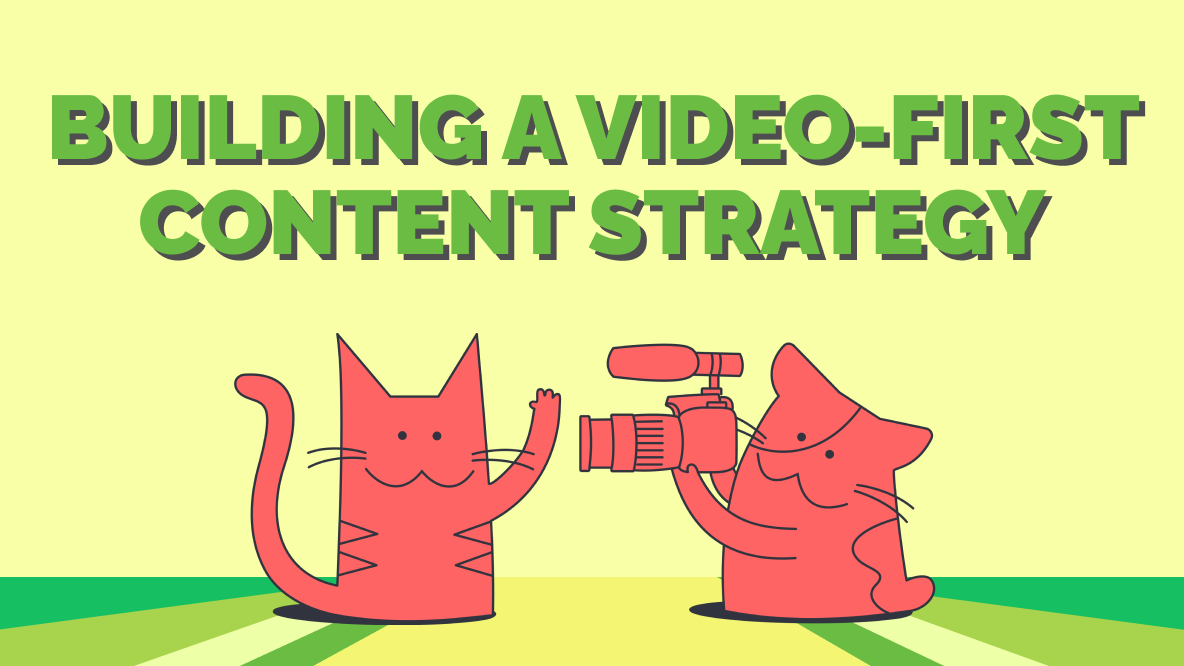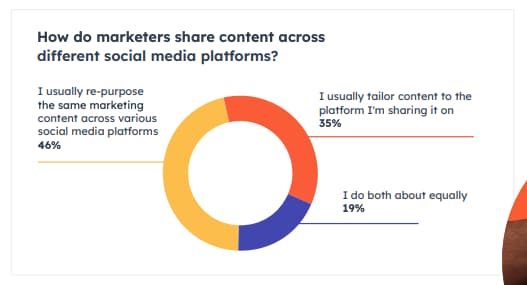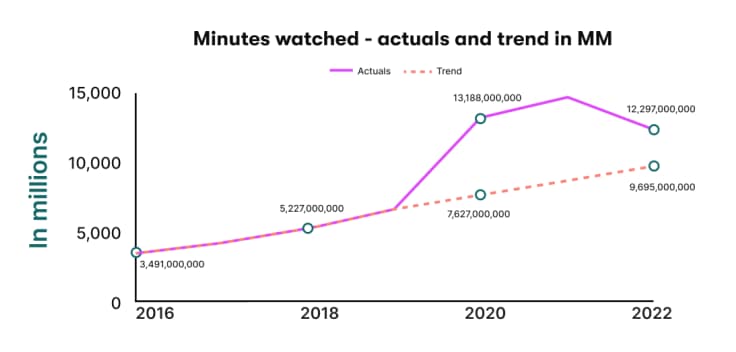Why You Should Build a Video-First Content Strategy
There's never been a better time to invest in a video-first content strategy. Find out why video is the perfect anchor medium for your brand.

Video isn’t the “future of marketing” anymore. It’s the standard – and has been for a while.
That doesn’t mean video marketing has stagnated, though. The importance of video continues to reach new heights due to larger macro trends in marketing. How and where your content team is investing in video might need to change if you want to keep up.
Let’s unpack what those trends are and why there's never been a stronger case to make video the anchor medium for your entire content marketing program.
Why make video your anchor medium?
First, what is an anchor medium?
We’re borrowing the phrase from John Bonini, Founder of Some Good Content Coaching.
In his words, you should pick *one* medium that you’re likely to excel at given your team’s talent or experience and the preferences of your audience. Content pieces from that one channel will inform unique content angles across all of those other mediums, too.
The default anchor medium for many brands used to be text. For so long, content marketing was equated with “blog post.” That has slowly shifted, with more companies looking to invest in video.
Now, we’re taking it a step further.
Video shouldn’t be a part of your content strategy. It should be the beating heart of it.
Here's why:
1. There is no better channel to build a content engine than video
The beauty of video, especially right now, is that you can repurpose content across every organic channel that matters for creating demand. HubSpot's data shows 46% of marketers say that repurposing is their primary approach to sharing content across channels, versus 35% who tailor content to each platform.

But there's a problem: many brands are guilty of mindlessly repurposing content without a clear strategy, which just becomes "Random Acts of Content" in another form.
Knowing how to smartly atomize and repurpose content has become crucial because it’s (a) the best way to test which content and messaging works and (b) the best way to double- and triple-down on winning content ideas.
Content atomization goes beyond just resizing clips and publishing them on multiple platforms. It’s more about the concept, or the narrative, behind the content. How do we take this idea that we came up with for one medium and create something new with it, tailor fitting it for a new platform?
This has never been more important than now, with a less robust economic environment and a “do more with less” mandate being handed down to marketing teams everywhere.
Creating content from scratch for every channel just isn’t feasible anymore. Especially when you’re faced with a video-first algorithm on most channels.
2. Video is the premiere channel for expert-first content
With written content, expertise is hard to source and even harder to prove. We've all seen brands invest in those extremely descriptive author bylines to try to imply a sense of authority—a surface-level attempt to tell search engines, "this author is knowledgeable." Your customers are far more discerning.
Here, video has yet another advantage. But first, let's talk about why this expertise matters.
Customers are savvier than ever, especially discerning B2B prospects. They’re both well-informed and bound by significant switching costs—it's hard to change the workflow of an entire team.
As a result, these buyers typically need to be convinced of your product's unique value and your company's point of view, so they can see how your product makes them more successful. What's at stake if they don't change the way they're doing things? What's going on in the market that makes your product the ideal choice for the future? Once a prospect has bought the problem, then you can sell them the solution.
Enter: video. Your marketing team (hopefully) deeply understands your customer's pain points, but it's unlikely they specialize in your customer’s craft or discipline. You can’t expect your team's content marketer or social media manager to also moonlight as a bonafide HR or cybersecurity expert.
So, how do you create content that informs, entertains, and influences your buyers? By talking to the actual experts. You interview them to draw out their expertise in a way that helps your audience and future buyers.
And if those conversations are recorded content (and they often are), you should definitely be using video. NPR might be able to get away with audio-only shows, but modern brands need video.
3. Existing channels are all seeing major shifts
HubSpot’s State of Marketing report says that brands plan on investing incrementally more of their budget in these three channels:
- Short-form video
- Influencer marketing
- SEO
Video is, of course, central to the first two channels, but it’s increasingly becoming important for SEO, too, which is what really matters.
SEO is one of the few ultra-scalable acquisition channels and video is influencing SEO strategy more and more. As a brand with lots of exposure to searches related to video, we’ve seen more videos appearing in the SERPs as well as more prominent placement of those video search results.
Additionally, many SERPs now show “video intent,” where only videos can rank for that coveted first position. We already know that younger consumers are more likely to go to YouTube or TikTok to search for a product or solution. But now even users who are still using Google are being guided to video results more frequently.
This is in line with video continuing its broader trajectory as the most preferred channel for consumers and prospects.

Looking at Wistia’s State of Video report, we can see that video consumption is way up:
- Audiences watched 12.2 million minutes of video in 2022.
- Audiences have been playing videos 59% more since 2019.
- Viewer video consumption is up 71% more than expected from 2019 levels.
While the actual number of minutes watched has decreased since 2020 (which saw a spike for… obvious reasons), video consumption has still remained well above the trendline for the last four years.
It's no wonder companies show such confidence in video's ROI over recent years:
- 52% of companies say that using product education videos to help prospects learn more about a product or service is their top goal in video marketing.
- 42% of companies say that assisting conversions in the sales cycle is a key indicator of success with video.
- 80% of marketers invested in live video events in 2022.
- Videos above 30 minutes saw over 11,000% growth over the past decade compared to 36% growth for videos under 30 minutes.

4. Video has never been easier to create—sort of
So, if all of this is true, why aren’t more marketing teams making video their anchor medium already? Because video is (still) comparatively hard to make. Or at least, brands believe that video is harder to make. And for a long time that belief was probably true for most companies.
There’s always been a production hurdle to clear when it comes to creating video.
We perceive written content as easier to produce because publishing a blog post or a tweet is now so turn-key: You don’t need to know HTML or CSS, you just click a button and your words are live on the internet.
Until very recently, video was still in that “building an HTML web page from scratch” phase.
But now, what it takes to make a video has undoubtedly gotten easier. Not only has the hardware and gear become more accessible – you can literally record HD video from the little computer you keep in your pocket, your phone – but the software has gotten better, too.
We’re seeing the rise of less bloated, more approachable video editing tools that are easy to learn but still powerful enough to produce quality video. Adding AI tools into the mix continues to democratize video creation even further.
In terms of pure technical process, the barrier to create video is lower than ever before. And will only continue to come down.
That said, what it takes to make a great, performant video is still more than you’d expect. We’re not talking about total views, but rather reaching the right viewers in a way that creates business impact. The success of a video still ultimately hinges on factors outside of the technical production:
What angle did we take? Do we actually understand our intended audience well enough to know what they care about, what challenges they’re facing, or what their interests are?
Now that video is easier to produce, marketers can spend more time focusing on these questions and nailing the actual substance of their video content. As video production gets easier, video strategy becomes more important.
If you can get that part right, atomizing your content for every other medium and channel gets that much easier.
Winning with a video-first content strategy
It’s ultimately up to you to look at your overarching business and marketing goals, build a content strategy that best supports them, and determine whether or not video needs to be a part of it. But for most teams, that answer is going to be yes.
If you decide to invest in video as your anchor medium, remember that it’s a long-term strategy. It’s unlikely that you’ll create one video, hit it big, and drive a million users to sign up for your product. Instead, be prepared to spend time learning what works, testing new things, and really investing in video strategy as well as production.
The marketers that can leverage new tools to bring down hurdles of creation and increase the total impact of their videos will go very far.
Create content faster with Kapwing's online video editor →








